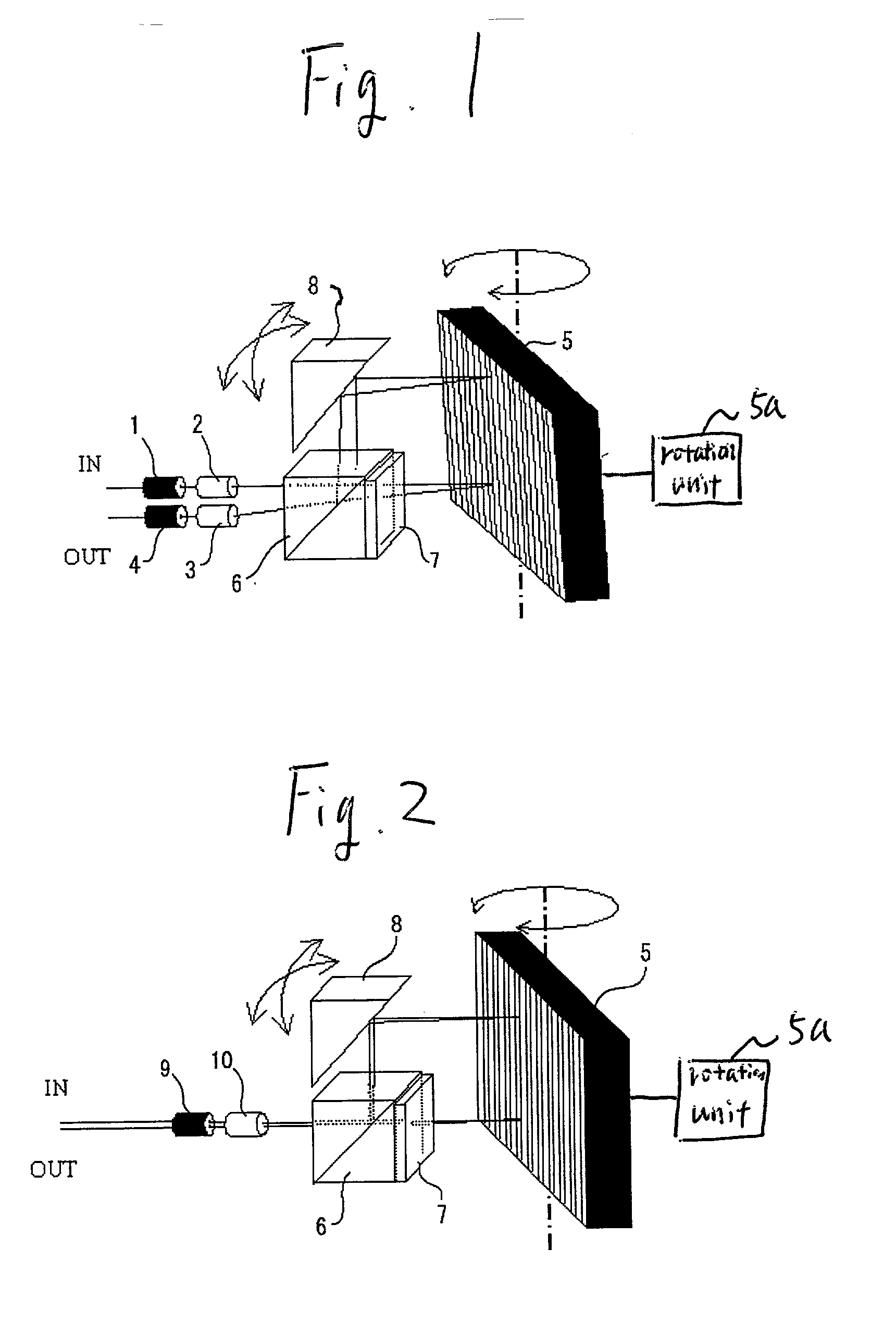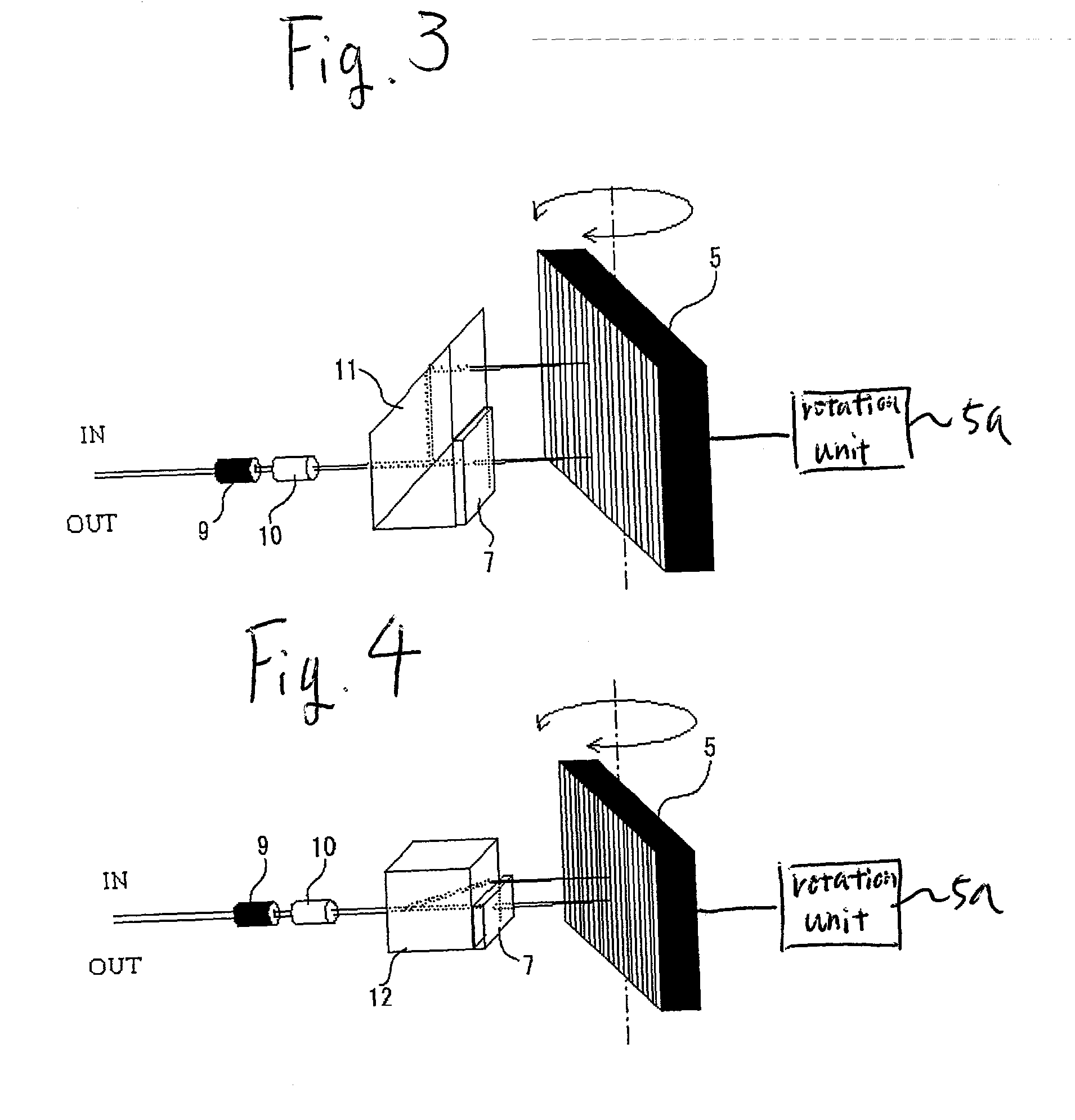Tunable filter
a filter and tunable technology, applied in the field of tunable filters, can solve the problems of difficult film application to the band-pass filter, difficult to increase the wavelength variable range, and change the thickness of the dielectric film, and achieve the effect of high diffraction efficiency
- Summary
- Abstract
- Description
- Claims
- Application Information
AI Technical Summary
Benefits of technology
Problems solved by technology
Method used
Image
Examples
first embodiment
[0048] FIG. 1 is a diagram showing a configuration of a tunable filter using a diffraction grating of the invention.
[0049] Numeral 1 is an input side optical fiber, numeral 2 is an input side condenser lens, numeral 3 is an output side condenser lens, numeral 4 is an output side optical fiber. The condenser lenses 2 and 3 may be a GRIN lens (gradient index lens).
[0050] Numeral 5 is a diffraction grating, and the diffraction grating is constructed rotatably as shown in the drawing in order to change an angle of incidence of light passing through the condenser lens 2. The diffraction grating is rotated by a rotation unit 5a.
[0051] Numeral 6 is a cube type polarizer, and numeral 7 is a polarization rotator. The polarization rotator includes a half-wave plate or a garnet thick film. As the wave plate, a zero-order wave plate capable of use at a wide wavelength band is preferable.
[0052] Numeral 8 is a mirror which is provided in order to output light from the polarizer 6 to the diffracti...
second embodiment
[0060] FIG. 2 is a diagram showing a configuration of a tunable filter using a diffraction grating of the invention.
[0061] Numeral 9 is a two-core fiber for input side light and output light, and numeral 10 is a condenser lens.
[0062] The condenser lens 10 may be a GRIN lens (gradient index lens).
[0063] Numeral 5 is a diffraction grating, and the diffraction grating is constructed rotatably as shown in the drawing in order to change an angle of incidence of light passing through the condenser lens 10. The diffraction grating is rotated by a rotation unit 5a.
[0064] Numeral 6 is a cube type polarizer, and numeral 7 is a polarization rotator. The polarization rotator includes a half-wave plate or a garnet thick film, and as the wave plate, a zero-order wave plate capable of use at a wide wavelength band is desirable.
[0065] Numeral 8 is a mirror which is provided in order to output light from the polarizer 6 to the diffraction grating 5 and also return the diffracted light to the polariz...
third embodiment
[0070] FIG. 3 is a diagram showing a configuration of a tunable filter using a diffraction grating of the invention.
[0071] Numeral 9 is a two-core fiber for input side light and output light, and numeral 10 is a condenser lens.
[0072] The condenser lens 10 may be a GRIN lens (gradient index lens).
[0073] Numeral 5 is a diffraction grating, and the diffraction grating is constructed rotatably as shown in the drawing in order to change an angle of incidence of light passing through the condenser lens 10. The diffraction grating is rotated by a rotation unit 5a.
[0074] Numeral 11 is a parallelogram prism type polarizer and has a function combining the cube type polarizer 6 and the mirror 8 in FIG. 2.
[0075] Numeral 7 is a polarization rotator, and the polarization rotator includes a half-wave plate or a garnet thick film, and as the wave plate, a zero-order wave plate capable of use at a wide wavelength band is desirable.
[0076] FIG. 7 is a diagram showing a concept of splitting input light...
PUM
 Login to View More
Login to View More Abstract
Description
Claims
Application Information
 Login to View More
Login to View More - R&D
- Intellectual Property
- Life Sciences
- Materials
- Tech Scout
- Unparalleled Data Quality
- Higher Quality Content
- 60% Fewer Hallucinations
Browse by: Latest US Patents, China's latest patents, Technical Efficacy Thesaurus, Application Domain, Technology Topic, Popular Technical Reports.
© 2025 PatSnap. All rights reserved.Legal|Privacy policy|Modern Slavery Act Transparency Statement|Sitemap|About US| Contact US: help@patsnap.com



